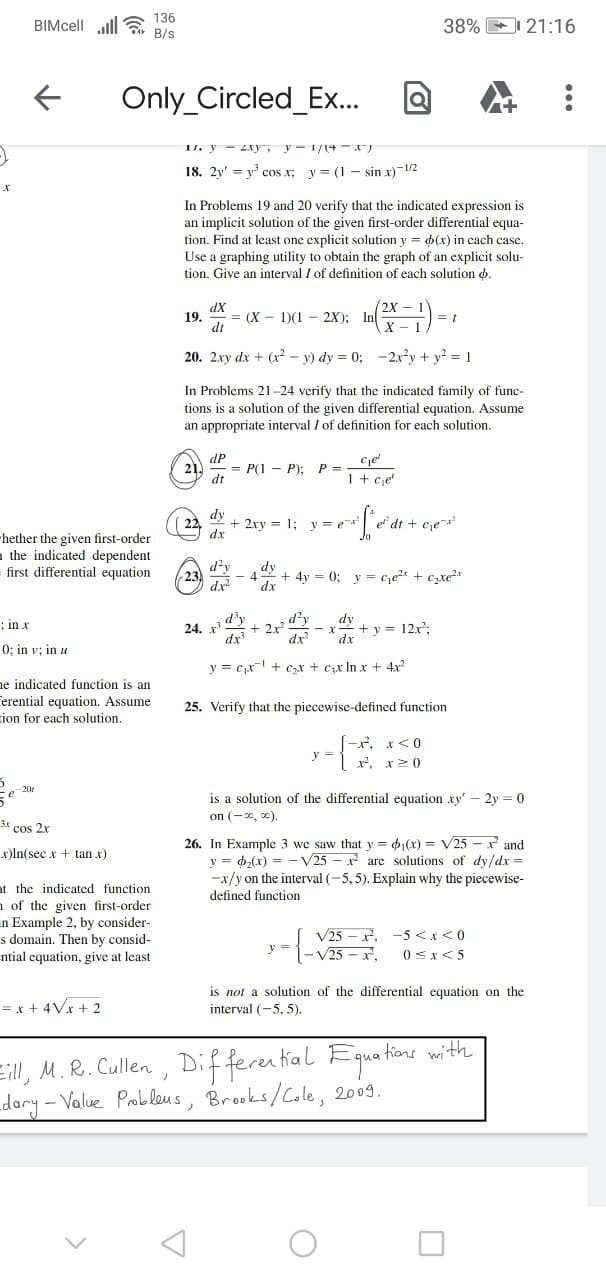2X - 1 dX 19. di = (x - 1(1 – 2X); In ) =1 20. 2xy dx + (x - y) dy = 0; -2xy + y = 1 In Problems 21-24 verify that the indicated family of func- tions is a solution of the given differential equation. Assume an appropriate interval I of definition for each solution. dP P(1 - P); P dt 1+ c,e dy 22 + 2ry = 1; y = e* e dt + dx Jo d'y 23 dy 4 + 4y = 0; y = ce + czxe²* dx dx d'y 24. x * 2 dy dx dy - x +y = 12x; y = cr + cx + cx In x + 4x 25. Verify that the piecewise-defined function S-r. x<0 x, x20 is a solution of the differential equation xy' – 2y = 0 on (-x, 0). 26. In Example 3 we saw that y = (x) = V25 - x and
2X - 1 dX 19. di = (x - 1(1 – 2X); In ) =1 20. 2xy dx + (x - y) dy = 0; -2xy + y = 1 In Problems 21-24 verify that the indicated family of func- tions is a solution of the given differential equation. Assume an appropriate interval I of definition for each solution. dP P(1 - P); P dt 1+ c,e dy 22 + 2ry = 1; y = e* e dt + dx Jo d'y 23 dy 4 + 4y = 0; y = ce + czxe²* dx dx d'y 24. x * 2 dy dx dy - x +y = 12x; y = cr + cx + cx In x + 4x 25. Verify that the piecewise-defined function S-r. x<0 x, x20 is a solution of the differential equation xy' – 2y = 0 on (-x, 0). 26. In Example 3 we saw that y = (x) = V25 - x and
Calculus: Early Transcendentals
8th Edition
ISBN:9781285741550
Author:James Stewart
Publisher:James Stewart
Chapter1: Functions And Models
Section: Chapter Questions
Problem 1RCC: (a) What is a function? What are its domain and range? (b) What is the graph of a function? (c) How...
Related questions
Question
i need the answer quickly

Transcribed Image Text:BIMcell ull a 136
B/s
38% 21:16
Only Circled_Ex...
11. y - Lxy; y- 1/4 -)
18. 2y' = y cos x; y = (1 - sin x)-1/2
In Problems 19 and 20 verify that the indicated expression is
an implicit solution of the given first-order differential equa-
tion. Find at least one explicit solution y = d(x) in cach case.
Use a graphing utility to obtain the graph of an explicit solu-
tion. Give an interval I of definition of each solution o.
dX
19.
dt
= (X – 1)(1 – 2X): In )
= t
20. 2xy dx + (x2 - y) dy = 0; -2x²y + y? = 1
In Problems 21-24 verify that the indicated family of func-
tions is a solution of the given differential equation. Assume
an appropriate interval / of definition for each solution.
dP
21
Cje
1+ c,e
= P(1 - P); P =
dt
dy
22
+ 2xy = 1; y = e*
dx
e dt + c,e
-hether the given first-order
a the indicated dependent
- first differential equation
d'y
23
dx
dy
+ 4y = 0; y = cje + c,xe2*
dx
d'y
d'y
dy
: in x
24. x
dx
+ 2x
+ y = 12x;
dx
dx
0; in v; in u
y = cx + C,x + cx In x + 4x?
ne indicated function is an
Ferential equation. Assume
ion for each solution.
25. Verify that the piecewise-defined function
-x. x<0
x², x2 0
y =
20
is a solution of the differential equation xy' - 2y = 0
on (-0, ).
3x cos 2x
26. In Example 3 we saw that y = d1(x) = V25 - x and
y = d,(x) = - V25 - x are solutions of dy/dx =
-x/y on the interval (-5, 5). Explain why the piecewise-
x)ln(sec x + tan x)
at the indicated function
a of the given first-order
en Example 2, by consider-
s domain. Then by consid-
ential equation, give at least
defined function
V25 – x, -5 <x< 0
-V25 - x.
y =
0 <x<5
= x + 4Vx + 2
is not a solution of the differential equation on the
interval (-5, 5).
tions with
Eill, M.R. Cullen , Dif feren tial Equat
dary-
- Value Pobleus, Brooks/Cole, 2009.
Expert Solution
This question has been solved!
Explore an expertly crafted, step-by-step solution for a thorough understanding of key concepts.
Step by step
Solved in 2 steps with 2 images

Recommended textbooks for you

Calculus: Early Transcendentals
Calculus
ISBN:
9781285741550
Author:
James Stewart
Publisher:
Cengage Learning

Thomas' Calculus (14th Edition)
Calculus
ISBN:
9780134438986
Author:
Joel R. Hass, Christopher E. Heil, Maurice D. Weir
Publisher:
PEARSON

Calculus: Early Transcendentals (3rd Edition)
Calculus
ISBN:
9780134763644
Author:
William L. Briggs, Lyle Cochran, Bernard Gillett, Eric Schulz
Publisher:
PEARSON

Calculus: Early Transcendentals
Calculus
ISBN:
9781285741550
Author:
James Stewart
Publisher:
Cengage Learning

Thomas' Calculus (14th Edition)
Calculus
ISBN:
9780134438986
Author:
Joel R. Hass, Christopher E. Heil, Maurice D. Weir
Publisher:
PEARSON

Calculus: Early Transcendentals (3rd Edition)
Calculus
ISBN:
9780134763644
Author:
William L. Briggs, Lyle Cochran, Bernard Gillett, Eric Schulz
Publisher:
PEARSON

Calculus: Early Transcendentals
Calculus
ISBN:
9781319050740
Author:
Jon Rogawski, Colin Adams, Robert Franzosa
Publisher:
W. H. Freeman


Calculus: Early Transcendental Functions
Calculus
ISBN:
9781337552516
Author:
Ron Larson, Bruce H. Edwards
Publisher:
Cengage Learning